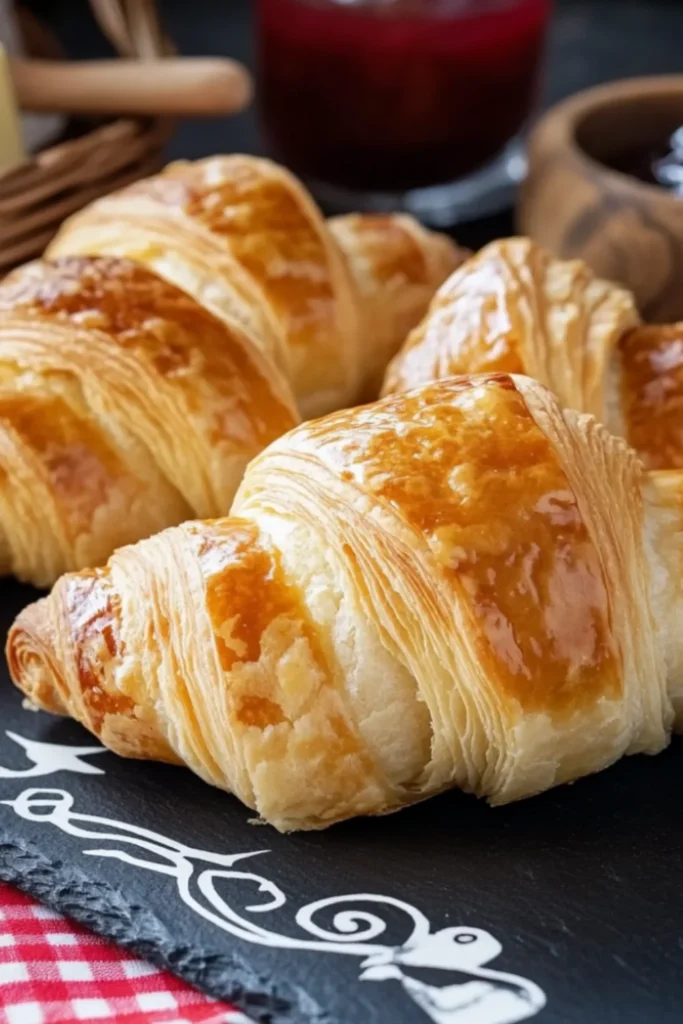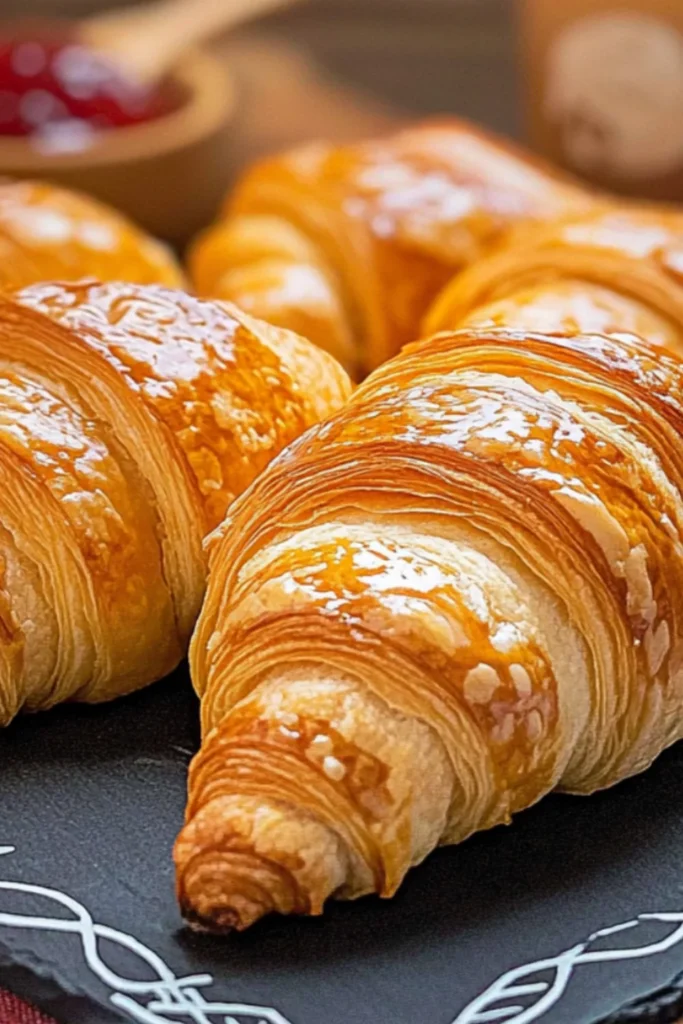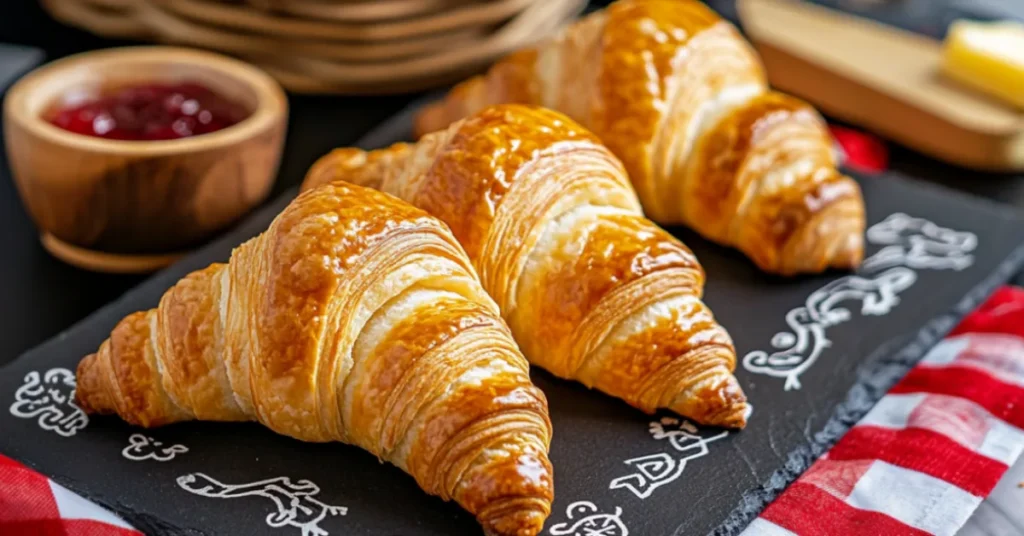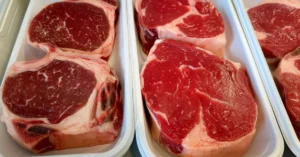Table of Contents
If you’ve ever wandered into a Swiss bakery, chances are you’ve encountered Gipfeli recipe—the Swiss version of croissants. With their flaky layers, buttery aroma, and irresistible taste, Gipfeli recipe are a breakfast staple in Switzerland and a treat worth mastering at home. Whether you’re a seasoned baker or a beginner, this article will guide you through everything you need to know about making Gipfeli from scratch.

From the history and cultural significance of Gipfeli recipe to a step-by-step recipe, tips for perfecting your technique, and creative variations, we’ve got you covered. So, roll up your sleeves, dust off your rolling pin, and let’s dive into the world of Gipfeli!
Introduction and Overview of Gipfeli Recipe
Introduction to Gipfeli Recipe
Imagine waking up to the smell of freshly baked Gipfeli—crispy on the outside, soft and buttery on the inside, and perfect with a cup of coffee or tea. These Swiss pastries, often compared to French croissants, are a beloved part of Swiss cuisine and a delightful addition to any breakfast or brunch spread.
In this article, we’ll explore the art of making Gipfeli recipe at home. From their fascinating history to the secrets of achieving those perfect flaky layers, you’ll learn everything you need to create these pastries like a pro.
What is Gipfeli?
Gipfeli (pronounced gip-feh-lee) is the Swiss German word for croissants. While they share similarities with their French cousins, Gipfeli have a unique identity. They’re typically less buttery and slightly denser, making them a versatile pastry that can be enjoyed plain, filled, or even as a sandwich.
The key to Gipfeli recipe lies in its laminated dough—a technique that involves folding butter into the dough to create those iconic flaky layers. When done right, each bite is a perfect balance of crispiness and tenderness.
Why Make Gipfeli at Home?
Sure, you can buy Gipfeli from a bakery, but there’s something special about making them at home. For starters, you get to control the ingredients, ensuring a fresh and high-quality result. Plus, homemade Gipfeli can be customized to your liking—whether you prefer them plain, filled with chocolate, or stuffed with savory ingredients like ham and cheese.
More recipes: Peanut Butter Ganache
Making Gipfeli recipe is also a rewarding experience. While it requires some time and patience, the process is meditative, and the end result is well worth the effort. Trust us, once you’ve mastered this recipe, you’ll never look at store-bought pastries the same way again.
History and Cultural Significance of Gipfeli
Every great dish has a story, and Gipfeli recipe is no exception. In this section, we’ll take a journey through the history of Gipfeli, explore its cultural significance in Switzerland, and uncover how it differs from its French counterpart, the croissant.
The Origins of Gipfeli
The story of Gipfeli recipe begins in Switzerland, where it has been a beloved pastry for generations. While its exact origins are a bit hazy, Gipfeli recipe is believed to have been inspired by the French croissant, which itself has roots in Austrian baking traditions.
Interestingly, the croissant made its way to France in the 19th century, and from there, it traveled to Switzerland, where it was adapted to local tastes. Over time, Swiss bakers put their own spin on the pastry, creating a version that was slightly less buttery and more versatile. Today, Gipfeli is a staple in Swiss bakeries and a symbol of Swiss culinary pride.
Gipfeli vs Croissants
At first glance, Gipfeli and French croissants might seem identical, but there are some key differences:
- Butter Content: French croissants are known for their high butter content, which gives them a rich, indulgent flavor. Gipfeli, on the other hand, uses less butter, resulting in a slightly denser texture.
- Shape: While both pastries are crescent-shaped, Gipfeli often has a more pronounced curve, making it visually distinct.
- Versatility: Gipfeli is often enjoyed as a sandwich or filled with sweet or savory ingredients, whereas French croissants are typically eaten plain or with a light spread of jam.
Fun Fact: In Switzerland, Gipfeli recipe is a popular breakfast item, often paired with coffee or hot chocolate. It’s also a common snack for hikers and travelers, thanks to its portability and satisfying texture.
Gipfeli in Modern Cuisine
Today, Gipfeli recipe continues to hold a special place in Swiss culture. It’s not just a pastry—it’s a part of daily life. Whether enjoyed at a cozy café in Zurich or grabbed on the go from a local bakery, Gipfeli recipe is a symbol of comfort and tradition.
In recent years, Gipfeli recipe has also gained popularity outside Switzerland, thanks to its versatility and delicious flavor. From trendy brunch spots to home kitchens, this Swiss pastry is making its mark on the global culinary scene.

Ingredients and Tools Needed
Before you start baking, it’s essential to gather the right ingredients and tools. After all, the quality of your Gipfeli recipe depends on the quality of what you put into it. In this section, we’ll break down everything you need to make perfect Gipfeli, from the basics to optional add-ins and equipment.
Essential Ingredients for Gipfeli recipe
Making Gipfeli requires a handful of simple ingredients, but each one plays a crucial role in achieving that perfect flaky texture and buttery flavor. Here’s what you’ll need:
- Flour: Use all-purpose flour or bread flour for the best results. Bread flour has a higher protein content, which helps create a chewier texture.
- Butter: High-quality unsalted butter is key. Look for butter with a high fat content (around 82%) for the best flavor and texture.
- Yeast: Active dry yeast or instant yeast will help the dough rise and develop its light, airy structure.
- Milk: Whole milk adds richness and helps tenderize the dough.
- Sugar: A small amount of sugar feeds the yeast and adds a hint of sweetness.
- Salt: Enhances the flavor and balances the sweetness.
Pro Tip: If you want to go the extra mile, try using European-style butter, which has a higher fat content and richer flavor.
Optional Add-Ins and Variations
While traditional Gipfeli is delicious on its own, you can get creative with fillings and flavors. Here are some ideas:
- Sweet Variations:
- Chocolate: Add a strip of dark or milk chocolate before rolling the dough.
- Almond Paste: Spread a thin layer of almond paste for a nutty, sweet filling.
- Cinnamon Sugar: Sprinkle a mixture of cinnamon and sugar for a cozy twist.
- Savory Variations:
- Ham and Cheese: Fill with slices of ham and your favorite cheese for a hearty snack.
- Spinach and Feta: Add a layer of sautéed spinach and crumbled feta.
- Pesto: Spread a thin layer of pesto for a burst of herbaceous flavor.
Fun Fact: In Switzerland, savory Gipfeli recipe sandwiches are a popular lunch option, often filled with ham, cheese, and fresh veggies.
Tools and Equipment
While you don’t need a fully stocked bakery to make Gipfeli, having the right tools can make the process much easier. Here’s what you’ll need:
- Rolling Pin: Essential for rolling out the dough to the right thickness.
- Baking Sheets: Use parchment-lined baking sheets to prevent sticking.
- Pastry Brush: For brushing the dough with butter or egg wash.
- Dough Scraper: Helps with cutting and shaping the dough.
- Stand Mixer (optional): While not necessary, a stand mixer with a dough hook can save time and effort.
Pro Tip: If you don’t have a stand mixer, don’t worry—you can knead the dough by hand. It might take a bit more effort, but the results will be just as delicious.
Step-by-Step Gipfeli Recipe
Now that you’ve gathered your ingredients and tools, it’s time to roll up your sleeves and get baking! Making Gipfeli recipe is a labor of love, but the results are absolutely worth it. In this section, we’ll guide you through each step of the process, from preparing the dough to shaping and baking your pastries to golden perfection.
Preparing the Dough
The foundation of any great Gipfeli is the dough. Here’s how to make it:
- Activate the Yeast:
- Warm 1/2 cup of milk to about 110°F (43°C).
- Add 1 packet (2 1/4 teaspoons) of active dry yeast and 1 teaspoon of sugar. Let it sit for 5-10 minutes until frothy.
- Mix the Dough:
- In a large bowl or stand mixer, combine 3 cups of flour, 1/4 cup of sugar, and 1 teaspoon of salt.
- Add the yeast mixture and 1/2 cup of cold water. Mix until a dough forms.
- Knead the dough for 8-10 minutes until smooth and elastic. If using a stand mixer, use the dough hook attachment.
- First Rise:
- Place the dough in a lightly oiled bowl, cover with a damp cloth, and let it rise in a warm place for 1-2 hours, or until doubled in size.
Pro Tip: If your kitchen is cold, place the dough in the oven with the light on to create a warm environment for rising.
Laminating the Dough
Laminating is the process of folding butter into the dough to create those flaky layers. Here’s how to do it:
- Prepare the Butter Block:
- Cut 1 cup (2 sticks) of cold butter into thin slices and arrange them into a 6×6-inch square on a sheet of parchment paper.
- Cover with another sheet of parchment and gently pound the butter with a rolling pin until it forms a smooth, even block. Chill in the fridge for 10 minutes.
- Roll and Fold:
- Roll the dough into a 10×10-inch square on a lightly floured surface.
- Place the butter block in the center of the dough and fold the edges over to encase the butter completely.
- Roll the dough into a 12×18-inch rectangle, then fold it into thirds (like a letter). This is called a single fold.
- Chill the dough for 30 minutes, then repeat the rolling and folding process two more times.
Pro Tip: Keep the dough and butter cold throughout the process to prevent the butter from melting and leaking out.
Shaping the Gipfeli recipe
Once your dough is laminated, it’s time to shape your Gipfeli:
- Roll the Dough:
- Roll the dough into a 12×18-inch rectangle, about 1/4-inch thick.
- Cut the Triangles:
- Cut the dough into long, narrow triangles, about 4 inches wide at the base.
- Roll into Crescents:
- Starting at the base of each triangle, gently roll the dough toward the tip, stretching it slightly as you go.
- Curve the ends inward to create the classic crescent shape.
Pro Tip: If the dough starts to get too warm, chill it for 10-15 minutes before continuing.
Baking the Gipfeli
Now comes the fun part—baking your Gipfeli to golden perfection:
- Preheat the Oven:
- Preheat your oven to 400°F (200°C) and line baking sheets with parchment paper.
- Egg Wash:
- Beat 1 egg with 1 tablespoon of milk and brush it over the shaped Gipfeli for a shiny, golden finish.
- Bake:
- Bake for 15-18 minutes, or until the Gipfeli are puffed and golden brown.
Pro Tip: Rotate the baking sheets halfway through baking to ensure even browning.
Cooling and Serving
Once your Gipfeli are out of the oven, resist the urge to dig in right away! Let them cool on a wire rack for at least 10 minutes. This allows the layers to set and ensures a perfect texture.
Serve your Gipfeli warm with a cup of coffee or tea, or enjoy them as a sandwich filled with your favorite ingredients.
Tips and Tricks for Perfect Gipfeli recipe
Even the most experienced bakers can run into challenges when making Gipfeli recipe. But don’t worry—we’ve got you covered with expert tips and tricks to ensure your pastries turn out flaky, buttery, and absolutely delicious. In this section, we’ll cover common mistakes to avoid, techniques for achieving perfect layers, and how to store and reheat your Gipfeli.
Common Mistakes to Avoid
Making Gipfeli is a rewarding process, but it’s easy to make a few missteps along the way. Here’s what to watch out for:
- Overworking the Dough:
- Kneading or rolling the dough too much can make it tough. Handle it gently to maintain its light, airy texture.
- Using Warm Butter:
- If the butter gets too soft, it can melt into the dough instead of creating distinct layers. Keep everything cold!
- Skipping Resting Times:
- Resting the dough between folds and before baking is crucial for developing flavor and texture. Don’t rush the process.
Pro Tip: If the dough becomes too sticky, chill it for 10-15 minutes before continuing.
Expert Tips for Flaky Layers
The secret to perfect Gipfeli lies in the layers. Here’s how to achieve that flaky, buttery goodness:
- Keep Ingredients Cold:
- Use cold butter, cold water, and even chill your flour if your kitchen is warm.
- Even Rolling:
- Roll the dough evenly to ensure consistent layers. Use a ruler to check the thickness if needed.
- Proper Folding:
- When laminating, make sure each fold is precise and even. This creates uniform layers that puff up beautifully during baking.
Fun Fact: The process of laminating dough is similar to making puff pastry, but with fewer folds for a slightly denser texture.
Storing and Reheating Gipfeli recipe
If you have leftovers (which is rare!), here’s how to store and reheat your Gipfeli:
- Storing at Room Temperature:
- Keep Gipfeli in an airtight container for up to 2 days.
- Freezing:
- Freeze unbaked Gipfeli on a baking sheet, then transfer to a freezer bag. Bake directly from frozen, adding a few extra minutes to the baking time.
- Reheating:
- To revive day-old Gipfeli, warm them in a 350°F (175°C) oven for 5-7 minutes.
Pro Tip: Avoid microwaving Gipfeli, as it can make them soggy.
Variations and Creative Ideas
One of the best things about Gipfeli is its versatility. Whether you’re in the mood for something sweet, savory, or seasonal, there’s a Gipfeli variation for every occasion. In this section, we’ll explore creative ways to customize your Gipfeli, from classic fillings to festive twists.
Sweet Gipfeli Variations
If you have a sweet tooth, these variations will take your Gipfeli to the next level:
- Chocolate Gipfeli:
- Add a strip of dark or milk chocolate before rolling the dough.
- Sprinkle with powdered sugar after baking for an extra touch of sweetness.
- Almond Gipfeli:
- Spread a thin layer of almond paste over the dough before rolling.
- Top with sliced almonds and a drizzle of icing after baking.
- Cinnamon Sugar Gipfeli:
- Mix 1/4 cup of sugar with 1 teaspoon of cinnamon and sprinkle it over the dough before rolling.
- Brush with melted butter for a sticky, caramelized finish.
Pro Tip: For an extra indulgent treat, serve sweet Gipfeli with a side of whipped cream or fresh berries.
Savory Gipfeli Variations
Savory Gipfeli are perfect for breakfast, lunch, or a quick snack. Here are some delicious ideas:
- Ham and Cheese Gipfeli:
- Layer slices of ham and your favorite cheese (like Gruyère or cheddar) on the dough before rolling.
- Brush with an egg wash and sprinkle with sesame seeds before baking.
- Spinach and Feta Gipfeli:
- Sauté spinach with garlic and mix it with crumbled feta cheese.
- Spread the mixture over the dough and roll as usual.
- Pesto Gipfeli:
- Spread a thin layer of pesto over the dough before rolling.
- Add sun-dried tomatoes or mozzarella for extra flavor.
Fun Fact: In Switzerland, savory Gipfeli sandwiches are a popular grab-and-go option, often filled with ham, cheese, and fresh veggies.
Seasonal and Festive Gipfeli
Celebrate the seasons with these festive Gipfeli variations:
- Pumpkin Spice Gipfeli:
- Add 1 teaspoon of pumpkin spice to the dough for a cozy fall flavor.
- Fill with a pumpkin cream cheese mixture for an extra treat.
- Cranberry-Orange Gipfeli:
- Mix dried cranberries and orange zest into the dough before rolling.
- Drizzle with an orange glaze after baking.
- Holiday Gipfeli:
- Add a pinch of nutmeg or cardamom to the dough for a festive twist.
- Decorate with colored sugar or edible glitter for a touch of holiday magic.
Pro Tip: Get creative with shapes! For special occasions, try shaping your Gipfeli into stars, hearts, or braids.
Frequently Asked Questions About Gipfeli
1. What is the difference between Gipfeli and croissants?
- Gipfeli are the Swiss version of croissants, typically less buttery and slightly denser than their French counterparts. They’re also more versatile, often enjoyed as sandwiches or filled with sweet or savory ingredients.
2. Can I make Gipfeli without a stand mixer?
- Absolutely! While a stand mixer can make the process easier, you can knead the dough by hand. It might take a bit more effort, but the results will be just as delicious.
3. How do I prevent the butter from leaking during baking?
- To avoid butter leakage, make sure the butter is cold and evenly distributed during the lamination process. If the dough gets too warm, chill it for 10-15 minutes before continuing.
4. Can I freeze Gipfeli dough?
- Yes, you can freeze the dough either before or after shaping. If freezing before shaping, let the dough thaw in the fridge overnight before rolling and baking. If freezing after shaping, bake directly from frozen, adding a few extra minutes to the baking time.
5. What is the best flour for Gipfeli?
- All-purpose flour or bread flour works best for Gipfeli. Bread flour has a higher protein content, which helps create a chewier texture.
6. How long does it take to make Gipfeli from scratch?
- Plan for at least 4-6 hours, including resting and baking time. While it’s a bit of a time commitment, the process is meditative and the results are well worth it.
7. Can I make Gipfeli ahead of time?
- Yes! You can prepare the dough the night before and let it rise in the fridge overnight. This slow fermentation process can even enhance the flavor.
8. Why didn’t my Gipfeli rise properly?
- If your Gipfeli didn’t rise, it could be due to expired yeast, insufficient kneading, or a cold kitchen. Make sure your yeast is fresh and your dough has a warm place to rise.




